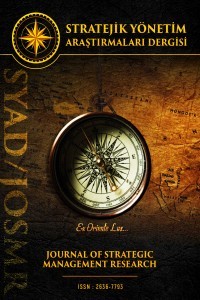Büyükşehir Belediyelerinin Stratejik Planlarının İçsel Tutarlılık Açısından Değerlendirilmesi
Bu çalışmanın amacı, büyükşehir belediyelerince hazırlanan stratejik planlar incelenerek, planların içeriğinde yer alan ana unsurlar arasında bir tutarlılık olup olmadığını ve dolayısıyla hazırlanan stratejik planların strateji olgusunun doğasına uygun ve bilinçli bir çabanın ürünü olarak hazırlanıp hazırlanmadığını ortaya koymaktır. İstanbul, Ankara ve İzmir Büyükşehir Belediyelerinin stratejik planlarını örnek olay temelinde içerik analizi ile inceleyen bu çalışmada, kurumların vizyon ve misyonlarının stratejik amaçlara ve hedeflere ışık tutup tutmadığını ve çevre algısı (FÜTZ) ile stratejik amaçlar arasında bir ilişki kurulup kurulmadığı sorularına yanıt aranmıştır. İnceleme sonucunda büyükşehir belediyelerinin stratejik planlarının büyük oranda içsel tutarlılığa sahip olduğu belirlenmiştir. Bu çalışma stratejik planların içsel tutarlılık analizinin nasıl yapılacağına dair bir sistematik geliştirmesi bakımından stratejik planlama yazınına katkıda bulunmaktadır.
Anahtar Kelimeler:
Stratejik tutarlılık, stratejik plan, stratejik plan unsurları, bütünsellik, büyükşehir belediyeleri
Evaluation of Strategic Plans of Municipalities İn Turkey: A Consistency Analysis
This study aims to explore whether there is a consistency between the core components of the strategic plans documented by metropolitan municipalities; and thus, to find out whether these plans are prepared as a product of conscious effort that is appropriate to the nature of the strategy phenomenon. Based on case studies of strategic plans of three major metropolitan municipalities, İstanbul, İzmir and Ankara, in Turkey, a content analysis is carried out in order to answer two research questions: (i) to what extent do vision and mission statements of these institutions shed light on their goals and objectives? and (ii) to what extent do their environmental perception relate to their goals and objectives? The analysis reveals that the strategic plans of the Metropolitan municipalities have a large extent of internal consistency. This study contributes to strategic planning literature by proposing a systematic rubric about how to conduct an internal consistency analysis of strategic plans.
Keywords:
Strategic Consistency, Strategic Planning, Components Of Strategic Plans, Completeness, Metropolitan Municipalities,
___
- Allison, M. ve Kaye, J. (2005). Strategic planning for nonprofit organizations, (2nd ed.), John Wiley, New York.
- Bart,C., ve Baetz, M. (1998). “The relationship between mission statements and firm performance: An exploratory study”. Journal of Management Studies, 35(6), 823–853.
- Boyd, B.K. (1991). “Strategic planning and financial performance: a meta‐analytic review”, Journal of management studies, 28(4), 353-374.
- Boyne G.A. ve Walker R.M. (2010). “Strategic Management and Public Services Performance: The way Ahead”, Public Administrative Review, 70:185–192.
- Bryson J.M. 2004. Strategic Planning for Public and Nonprofit Organizations. A Guide to Strengthening and Sustaining Organizational Achievement, III ed. San Francisco: John Wiley & Sons.
- Bryson, J.M. (2004). Strategic planning for public and non-profit organizations: a guide to strengthening and sustaining organizational achievement, (3rd ed.), Jossey-Bass, San Francisco, CA.
- Campbell, A. (1993), “The power of mission: aligning strategy and culture”, Planning Review, Special Issue.
- Campbell, A. ve Yeung, S. (1991). “Brief case: Mission, vision and strategic intent”. Long Range Planning, 24(4),145–147.
- Chance, S. ve Williams, B.T. (2009). “Assessing university strategic plans: A tool for consideration”, Educational Planning, 18 (1), p. 38-54
- De Carlo, M., Cugini, A., ve Zerbini, F. (2008). “Assessment of destination performance: A strategy map approach”, Tourism Review, 63 (2), p. 25-37
- Drucker, P. F. (1980). The deadly sins in public administration. Public administration review, 40(2), 103-106.
- Dutton, J.E. ve Duncan, R.B. (1987). “Strategic Issue Diagnosis and Its Relationship to Organizational Change”, Strategic Management Journal, 4, 1987, p. 307-323.
- Hartzell, G. (2002). “Controlling your own destiny: Why mission and vision statements are indispensable”, School Library Journal, 48 (11), p. 37
- Heracleous, L. (1998). "Strategic Thinking or Strategic Planning?", Long Range Planning, vol. 31, Iss. 3, June 1998, p. 481-487.
- Ireland, R.D. ve Hitt, M.A. (1992), “Mission statements: importance, challenge and recommendations for development”, Business Horizons, May-June.
- Kirkpatrick, S. (2008). “How to build a better vision statement”, Academic Leadership, 6 (4).
- Matheson, A., Scanlan, G. ve Tanner, R. (1997). Strategic management in government: extending the reform model in New Zealand. Benchmarking, Evaluation and Strategic Management in the Public Sector, 81-103.
- Rigby, D. (2001). “Management tools and techniques: A survey”, California Management Review, 43: 139-151.
- Rigby, D. ve Bilodeau, B. (2011). Management tools and trends, Boston: Bain & Company
- Whittington, R. (2006). “Completing the practice turn in strategy research”, Organization Studies, 27: 613-634.
- Wolf, C. ve Floyd, S. W. (2017). “Strategic planning research: Toward a theory-driven agenda”, Journal of Management, 43(6), 1754-1788.
- ISSN: 2636-7793
- Yayın Aralığı: Yılda 2 Sayı
- Başlangıç: 2018
- Yayıncı: Kubilay ÖZYER
Sayıdaki Diğer Makaleler
Özel Sağlık Sektöründe Mavi Okyanus Stratejisi
Mustafa AMARAT, Mahmut AKBOLAT, Özgün ÜNAL, Türker BAŞ
Kubilay ÖZYER, Musa Said DÖVEN
Büyükşehir Belediyelerinin Stratejik Planlarının İçsel Tutarlılık Açısından Değerlendirilmesi
Mahmut HIZIROĞLU, Mehmet Ali KARAKÖSE, Sinan CENGİZ
Prof. Dr. Mehmet BARCA'dan Editöre Mektup
Prof. Dr. Ömer TORLAK'tan Editöre Mektup
Misyon Ve Vizyon İfadeleri Kurumu İfade Etmekte midir: Kamu Hastane Birlikleri Örneği
